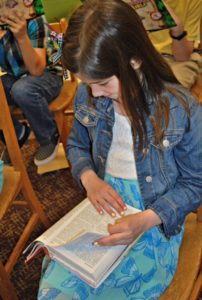
“Tell me and I forget, teach me and I may remember, involve me and I learn.” Benjamin Franklin
Research suggests that eighty-seven percent of all learners learn through kinesthetic activities. [1] Children are no exception and thrive on opportunities provided through experiential learning and hands-on activities. With this in mind, classrooms need to be a reflection of how children learn best. Below are five practical ways in which you can actively engage children in your Sunday school classroom:
#1: Provide an Interactive Environment. Children learn best when they are involved in the process of learning. Optimal learning can be facilitated by engaging children and encouraging them to be active in the classroom, not merely spectators. Some tangible ways in which we engage students include: collaborating with other children, problem solving, manipulating objects, and by exercising independence. Active learning not only increases a child’s performance in the classroom but also helps with the retention of knowledge.
#2: Plan Ahead with Classroom Preparation. Bill Emeott states, “The best session is a planned session.”[2] Providing an active learning environment will take time, careful planning and intentionality. Be creative in your ideas and be flexible with the learning process. For instance, allow children an opportunity to problem solve together, let them move about freely using objects to build, or encourage them to tell the teaching story in their own words. Developmentally appropriate practices will help you determine what is age appropriate and feasible for each child. Never challenge a child beyond their capability, but lead them towards success.
#3: Relationships Matter. An effort must be made to know the children you work with and to understand their unique learning styles. Each child is different and they learn in different ways. Understanding what communicates best to the children you serve will make the learning experience both meaningful and memorable. A teacher is an observer, an active supporter and actively engages children in conversation. According to Erika Christakis from The Atlantic, “Conversation is gold. It’s the most efficient early-learning system we have.”[3]
#4: Commit to Long-Term Benefits. Children will not comprehend everything you teach immediately. It takes time for information to be processed and each spiritual truth you share will be reinforced by teachings they will receive as they grow older. Be committed for the long-term, knowing that you are an integral part of this process. Making the learning process memorable and interactive will enable a child to recall those moments as they grow older and the teachings are reinforced.
#5: Repetition Is Vital. Children enjoy and need repetition. Allow children the opportunity to tell and retell the story in their own way. Have them recite a verse or an important concept over and over again. Make it fun and exciting.
[1]. Donna Walker Tileston, “What Every Teacher Should Know about Learning, Memory, and the Brain” (Thousand Oaks, CA: Corwin, 2004).
[2]. Lifeway Church Resources, Wholly Kids: Guiding Kids to Life in Christ, (Nashville: Lifeway Ministry Publishing, 2015), 121.
[3]. Erika Christakis, “The New Preschool is Crushing Kids: Today’s Young Children are Working More, But They’re Learning Less.” Last modified (January/February 2016). Accessed on December 3, 2021. https://www.theatlantic.com/magazine/archive/2016/01/the-new-preschool-is-crushing-kids/419139/
Jennifer Howington is the Childhood Ministry Specialist for Texas Baptists